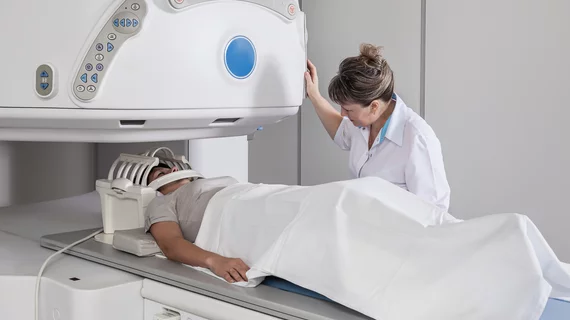Insights into early MRI-termination risk factors offer helpful strategies for prevention
Crediting improvements in MRI technology and a scheme to identify people at high risk of MRI interruptions before starting the procedure, researchers at Geneva University Hospitals in Geneva, Switzerland, note that MRI interruptions appear to be rare events in recent years. In a new European Journal of Radiology study, they found that just 0.8% of patients who undergo MRI—less than 1 in 100—experience early termination.
Still, even a small number of early terminations can be costly, in addition to creating negative experiences for patients. With this in mind, the study’s authors analyzed risk factors in order to understand underlying issues as well as prevention strategies that can help hospitals and private practices become more efficient.
Here, their main takeaways after examining records from over 22,500 patients are distilled into two categories: observations on claustrophobic-related terminations (which represent 56% of the total) and observations on non-claustrophobia-related terminations (representing the remaining 44%).
Takeaways related to claustrophobia-related terminations
1. Wide bore machines may not make a significant difference.
For patients with known claustrophobia, the study found only a slight, statistically insignificant difference in termination levels between wide bore (70 cm) and standard bore (60 cm) MRI machines, with respective terminations of 6.2% compared with 8.5%.
“Therefore, our study suggests that the impact of the bore aperture wideness on the onset claustrophobic event is probably overestimated,” the authors wrote.
2. Prior history of claustrophobia is highly correlated with early terminations.
People with a known prior history of claustrophobia were 33 times more likely to experience an early MRI termination than those without any prior history (6.6% compared with 0.2%).
This appears to justify the hospital’s policy of not only questioning patients about their history of claustrophobia before performing the procedure, but offering options to mitigate claustrophobia during the procedure, such as projecting a movie on the in-room TV monitor.
3. Inpatients are more likely to undergo early termination for claustrophobia than outpatients.
Inpatients were 1.5 times more likely to experience claustrophobia-related interruptions (0.6% versus 0.4%), with the study's authors postulating that this may be because prior history is likely underreported in inpatients, because they are often older or in poor condition.
This line of thinking serves as an emphasis of how important it is to gain prior history information whenever possible.
4. Claustrophobia-related interruptions increase slightly when the head or upper body are in or close to the gantry.
While physical positioning had a weaker correlation with early terminations than both prior history and inpatient status, the study found that it did still make a significant difference. For example, the highest rate of claustrophobia-related interruptions took place for thorax MRI (0.9%) and the lowest for the lower limbs (0.1%).
To mitigate these risks, the hospital uses prism glasses or a mirror when a patient’s head is in the gantry.
5. Age and gender are unhelpful predictors.
Contrary to previous studies that found conflicting correlations between age or gender and early MRI terminations, the Geneva University Hospital study found no significant differences in early terminations by age or gender, suggesting that these should not be considered risk factors.
Takeaways related to non-claustrophobia early terminations
1. Understand the leading causes of terminations.
While many hospitals and private practices have procedures in place to identify people at risk for claustrophobia during MRI, fewer seem knowledgeable about the many reasons that MRIs are interrupted, which are entirely unrelated to claustrophobia, the authors note.
Based on their research, these include:
- Agitation (31% of non-claustrophobia-related interruptions)
- Technical problems (29%)
- Pain (26%)
- Morphological constraints (14%)
The first step to understanding how to prevent these interruptions is to understand why they’re happening.
2. Elderly inpatients are at the highest risk.
Unlike claustrophobia-related terminations, old age was correlated with a higher rate of other terminations. Patients older than 65 were three times as likely than patients younger than 65 to experience an interruption (0.6% compared with 0.2%).
Also at significantly higher risk were inpatients (0.7% versus 0.2%).
Patients with both of these risk factors—in other words, inpatients over the age of 65—appear to be at the highest risk of early MRI terminations, with an interruption rate of 0.8% compared to just 0.2% for outpatients under the age of 65.
